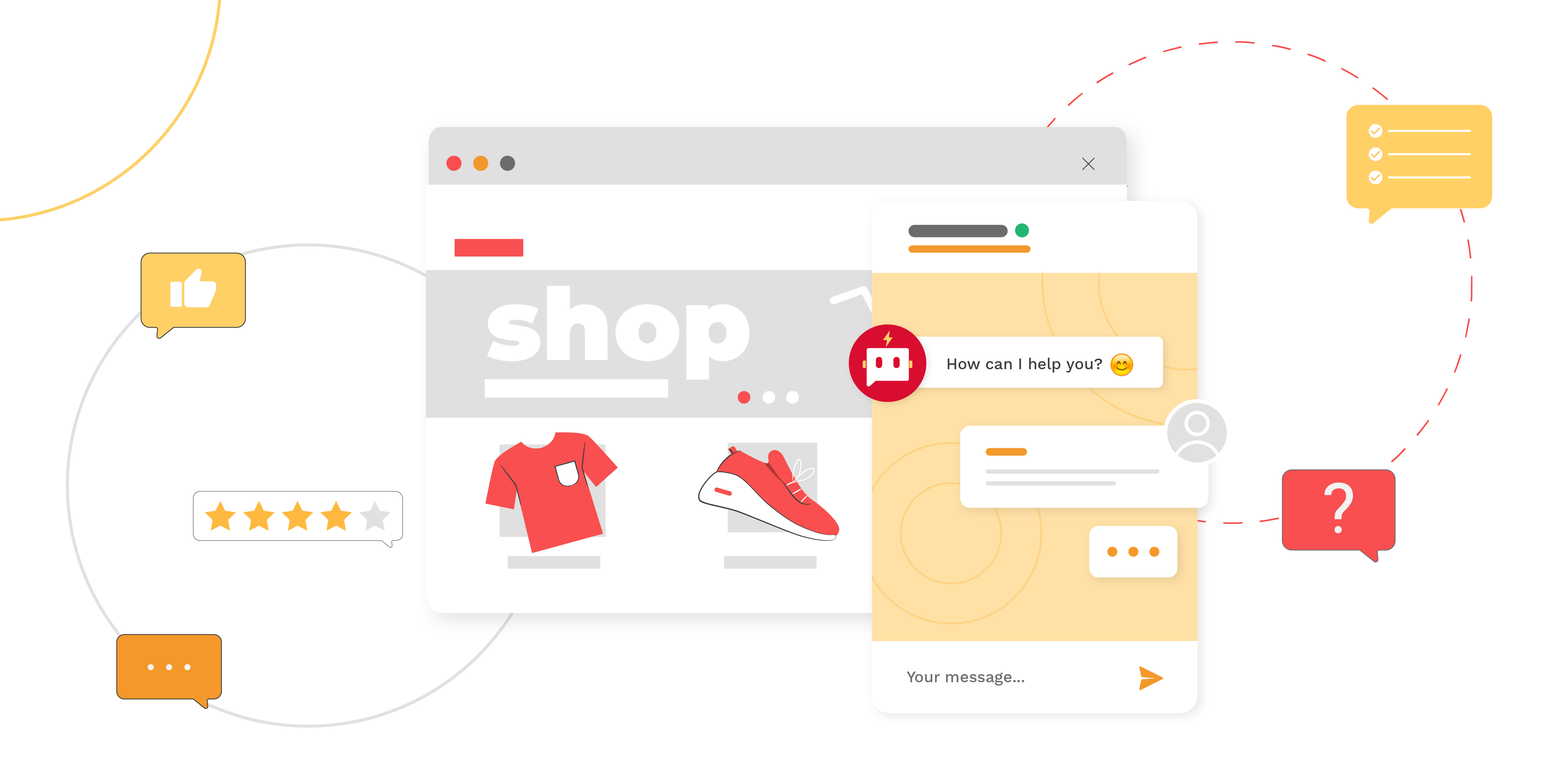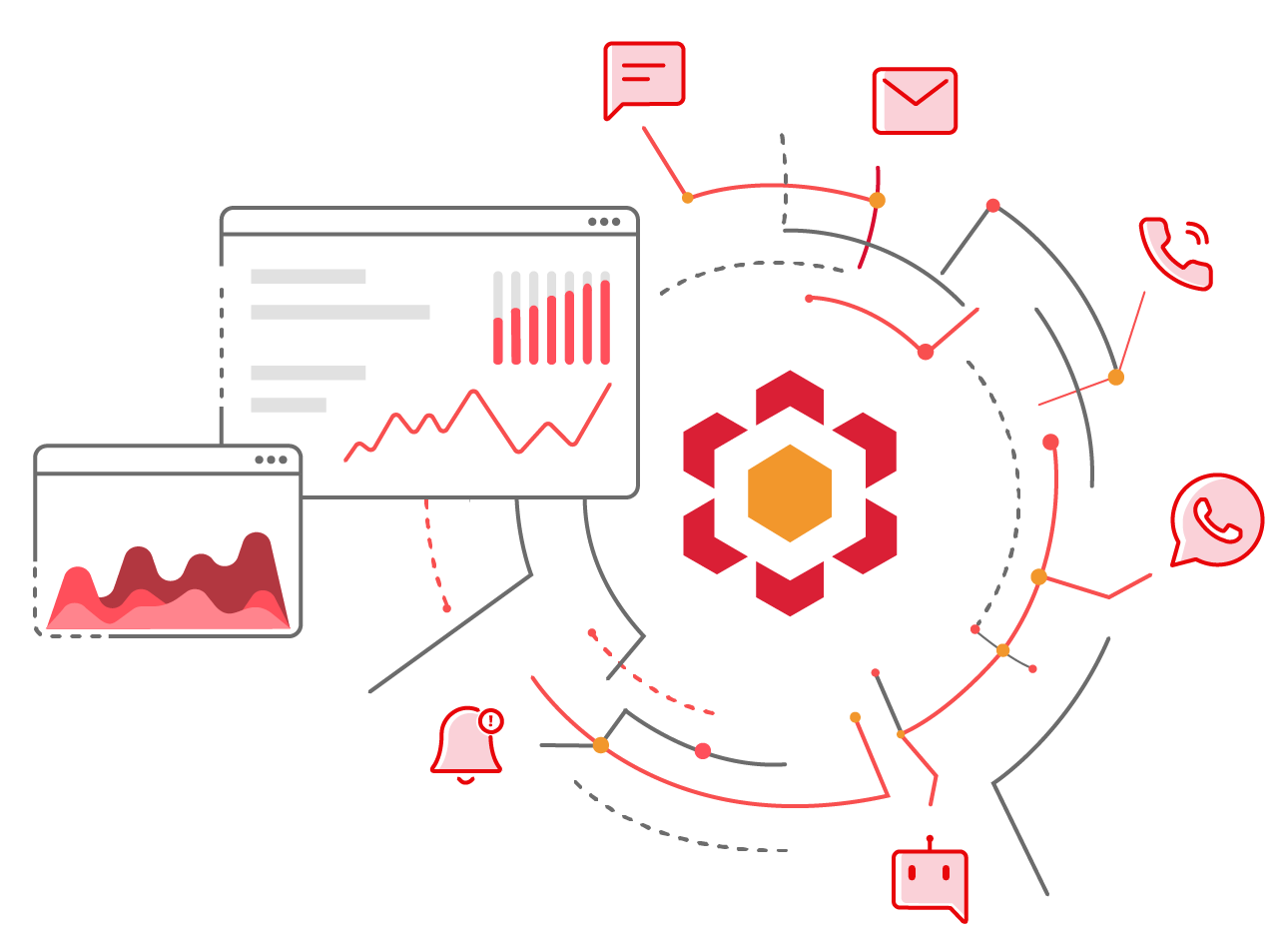
Chatbots have emerged as a powerful tool for conversational marketing, allowing businesses to engage with their customers in an automated and personalized way. In 2023, chatbot usage is only expected to increase as more and more brands realize the benefits of using conversational interfaces to drive sales and build customer loyalty. Learn how e-commerce businesses can use chatbots to engage customers, drive conversions, and ultimately grow their revenue using chatbots.
A chatbot is an AI-driven customer service automation tool that streamlines engagement operations and increases engagement capacity. To replicate human-like interactions, intelligent chatbots use preprogrammed rules and behaviors. When configured correctly, bots can save enterprises time, money, and human resources.
What is conversational marketing, and where does it fit into your marketing strategy?
Conversational marketing involves engaging with potential customers in a one-to-one conversation, leveraging personalized messages to create an approachable and human brand experience. This allows brands to communicate with their audiences in a more authentic and natural way, leading to higher engagement and conversion rates.
Chatbots are driving the interaction engine in an era of relationship marketing. Conversational marketing requires stakeholders to connect, listen and deliver in order to build trust between a brand and a customer. It enables enterprises to understand clientele better and anticipate their demands for customized solutions. In this article, we’ll delve deeper into what conversational marketing is and various use cases of chatbots in marketing.
How Do Chatbots Improve Customer Engagement and Experience?
Chatbots have rapidly become a preferred tool for businesses to enhance customer engagement and provide an exceptional experience. With cutting-edge advancements in artificial intelligence and natural language processing, chatbots have become increasingly intelligent and capable of meeting the needs of customers on a personalized level.
Here are some ways chatbots can improve customer engagement and experience.
- 24/7 Availability: Customers can get help or assistance from chatbots at any time, regardless of business hours.
- Quick Responses: Chatbots can respond to customer queries instantly and accurately without any delays or human error. As a result, customer problems are resolved faster, and customer satisfaction is improved.
- Personalization: Chatbots can use data from previous interactions with customers to offer tailored recommendations.
- Cost-Effective: Chatbots are more cost-effective than hiring additional staff to assist customers. A high volume of requests can be handled at once, reducing the need for human customer service representatives.
- Improved Consistency: Chatbots can provide a consistent experience for every customer interaction, regardless of the time of day.
- Enhanced Customer Insights: Chatbots can collect valuable data about customer preferences, behavior, and pain points, which can be used to improve products and services.
A prime example of chatbots improving customer experience is Bank of America’s Erica. Erica is an AI-powered chatbot that understands customers’ banking accounts and transaction history and helps them make smarter financial decisions. Customers can interact with Erica via messaging and get real-time updates on their account balances, money transfers, bill payments, and more.
Another instance that accentuates the critical use of chatbots in enhancing customer engagement is H&M’s chatbot. The famous retail brand implemented a chatbot within its mobile app. Customers can ask the chatbot for outfit advice, and the chatbot will offer suggestions based on the customer’s preferences, season, and occasion. This shopping assistant adds a personal touch to the customer experience, often lacking in online shopping, leading to a better overall experience and increased customer loyalty.
What are the Different Types of Chatbots?
There are different types of chatbots based on their functionality and underlying technology. Some of the common types of chatbots are:
Menu/Button-Based Chatbots
Menu or button-based chatbots are rule-based bots that work by providing users with a list of predetermined options to choose from. These options are generally presented as buttons or menus, allowing the user to guide the conversation’s direction. Menu/button-based chatbots are simple to develop, making them a popular option for businesses starting with bot development.
Linguistic/ Rule-Based Chatbots
Linguistic or rule-based chatbots are designed to work based on a set of rules defined by the developer. This type of chatbot is programmed to recognize keywords, phrases, or patterns in user input and respond appropriately.
Keyword Recognition-Based Chatbots
Keyword Recognition chatbots are similar to rule-based chatbots, but they use more advanced algorithms to identify and comprehend user input. These chatbots use natural language processing techniques to understand and respond to user queries, making them more sophisticated than rule-based chatbots.
Hybrid Model Chatbots
Hybrid model chatbots are a blend of rule-based and machine-learning chatbots. This type of chatbot has the potential to generate higher accuracy and reliability than rule-based chatbots. Hybrid model chatbots use machine learning algorithms to train a bot model that enforces domain rules.
Machine Learning Chatbots
Machine learning chatbots use artificial intelligence algorithms to modify their behavior and improve conversation quality over time. They rely on vast amounts of data to learn, so they can learn to hold full conversations and understand more complex questions.
Each of these chatbots has its unique strengths and weaknesses, making it imperative to consider the bot’s purpose before selecting the type of chatbot to develop. Businesses requiring basic functions can opt for Menu/Button and Rule-based chatbots, while those requiring more sophisticated features can opt for machine-learning chatbots. Whatever type of chatbot you choose, ensuring it engages the customer and treats them as humans instead of bots is essential.
How Do Businesses Create and Customize Chatbots for Conversational Marketing?
Creating and customizing a chatbot for conversational marketing requires careful planning and development work but pays off in improved customer engagement in return. With a well-designed conversation flow combined with an intuitive platform and proper training of your AI assistant – your business can be able to provide its customers with an interactive experience while answering their questions quickly & efficiently.
Here are a few easy steps your business can follow to create and customize chatbots for conversational marketing.
- Define the Use Case: The first step in creating a chatbot is to define the use case. What is the primary purpose of your chatbot? Is it to answer customer inquiries, offer promotions or discounts, provide product information, or something else entirely? Once you’ve determined the use case for your chatbot, you can move on to the next step.
- Choose the Chatbot Platform: Many different platforms are available for creating and customizing chatbots. Popular options include Watson Assistant, Google Dialogflow, Amazon Lex, Microsoft Bot Framework, and more. It’s important to choose a platform that fits your budget and meets all of your needs.
- Design the Conversation Flow: Once you’ve chosen a platform for your chatbot, it’s time to design the conversation flow. This involves mapping out how you want conversations between customers and your chatbot to go. You should also consider what questions customers might ask so that you can create appropriate responses.
- Developing the Chatbot: After designing the conversation flow, it’s time to get into developing your chatbot. This involves programming logic into your bot so that it can understand customer queries and respond appropriately. Depending on which platform you chose earlier, this step may involve writing code or using graphical tools like drag-and-drop components.
- Train the Chatbot: After developing your bot, training it before deploying it into production is essential. Training helps ensure that your bot is able to respond accurately to customer queries as expected. This step typically involves testing various scenarios with actual users and adjusting until everything works properly.
- Integrate with Marketing Channels: Finally, once you have trained your bot successfully, you will need to integrate it with other marketing channels, such as websites or social media accounts, so that customers can access it from anywhere they like. This typically involves connecting APIs between platforms so that data can be shared between them seamlessly.
6 Smart Ways Your Business Can Use Chatbots for Conversational Marketing
Chatbots have revolutionized the way businesses interact with their customers. In the era of conversational marketing, chatbots can be employed in a variety of ways to enhance the customer experience and deliver real value.
Here are six ways your business can use chatbots to take your conversational marketing game to the next level:
1. Boost the Volume of Marketing Conversations
By utilizing chatbots to take on some of the more routine conversations, you can free up time to focus on thrusting your marketing campaigns into overdrive. Chatbots offer automated responses to general inquiries, freeing up personnel for more important tasks associated with boosting the volume of marketing conversations.
For example, several banks are using them to answer basic banking queries such as account balances and tips for saving money.
Companies like Nike, Pizza Hut, and Mastercard are already leveraging the power of automation through chatbots – from helping customers find product information and providing interactive customer surveys to offering digital promotions, customer support, and more.
With a chatbot, your business can have 24/7 access to customer needs while overseeing multiple conversations happening in real-time. This opens up numerous possibilities when it comes to collecting data and assessing customer trends that could be used as valuable insights in their future campaigns.
With more customers getting comfortable talking to bots on a regular basis, brands gain the potential of being able to increase their marketing engagements without having to invest extra time or staff.
2. Auto Qualify Your Leads
By implementing automated chatbots, you can harness the power of AI technology to easily qualify leads and build relationships with customers that would not be feasible with only human interaction. Chatbots are uniquely suited for this task because they are able to rapidly examine data from customer interactions and quickly determine whether said interactions should be generated into a lead.
You can also further streamline your lead qualification process by setting specific qualifying criteria for your chatbots, so they can autonomously handle lead qualification for each incoming lead.
With the ability of chatbots to answer frequent customer inquiries and speed up the response time on customer service issues, your business will be able to increase its efficiency and free up more team members for strategic planning roles, which will further increase its success rate.
3. Nurture the Captured Leads
You can use chatbots to guide leads further down the sales funnel by automating conversations and providing relevant content with personalization. Furthermore, by including interactive tools such as self-guided tools, which enable customers to test a product or service without subscribing, and offering easy access to customer service representatives, your business can provide an efficient customer experience that nurtures leads and paves the way for potential sales.
These automated conversations give your brand valuable insight into the interests of potential customers; this data can be used to develop more precise marketing channels and drive further engagement.
Many leading brands, such as Sephora and Louis Vuitton, are already making effective use of chatbot technology to provide customers with personalized shopping experiences as well as providing support and helpful insights.
4. Schedule Meetings
An effective way for your business to handle the scheduling of meetings is by making use of chatbots. This can be done by programming the bots to communicate with customers and handle simple tasks like setting appointments and providing confirmations. By implementing a chatbot technology to schedule meetings, your brand will have an automated assistant readily available 24/7. Chatbots that are programmed specifically with the intention of setting up customer appointments can collect customer details like contact information and preferred times, ensuring that management resources are not being wasted on tedious tasks.
You will easily be able to save time and resources that would traditionally be spent on an administrative role with this technology, resulting in cost savings.
Customers are more likely to appreciate the enhanced convenience of chatbot-driven appointment scheduling since it allows for greater control over when and how they access services.
5. Personalize The User Experience
Chatbots provide an intuitive and interactive way to personalize the user experience. By leveraging AI and machine learning, they can optimize customer conversation flow while providing tailored solutions through natural language processing. You can use Chatbots to offer users product recommendations, detect their purchasing intent, respond with contextual information regarding products and services, and automate customer service inquiries based on predefined criteria.
Depending on the business model, chatbot conversations could also include upselling items or services as well as collecting consumer feedback by engaging in interactive surveys. With the advent of more sophisticated technologies such as keyword spotting, sentiment analysis, and bigger datasets for bots to learn from, chatbots offer a great opportunity for businesses to seamlessly personalize the user experience.
6. Offer Order Tracking & Shipment Details
With chatbots, you can provide customers with an effortless way to track orders and shipment details in real-time, enhancing the customer experience and allowing them to stay informed on the progress of their orders. For example, Nike’s chatbot allows consumers to track their orders from start to finish with regular updates on movement and shipping, proactively providing them with important shipment details. This helps customers stay updated without having to contact customer service representatives.
By taking advantage of this state-of-the-art customer service tool, you can gain an edge over your competitors while providing an efficient and streamlined communication process for your customers.
In Summary
As chatbot technology continues to evolve, businesses will have more opportunities to leverage chatbots for conversational marketing in 2023 and beyond. It is essential to note that chatbot usage will require a deep understanding of the customer’s needs, preferences, and behavior. Businesses that integrate chatbots into their marketing strategy must ensure that they deliver high-quality and relevant content that resonates with the customers.
By staying up-to-date with advancements in conversational marketing and using chatbots strategically, brands can maximize the potential reach and use campaigns that will speak to customers more authentically than ever before. Having the ability to engage with customers more organically is becoming increasingly critical for the success of an organization, so looking beyond traditional marketing efforts is paramount for those aiming to define ambitious goals in 2023.

Harish Thyagarajan
Content Marketer
Supercharge Your Communication!
Get in touch with our experts who strive hard to bring the very best in cloud communications technology to you.

